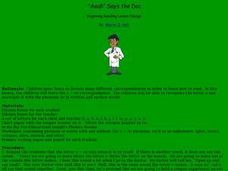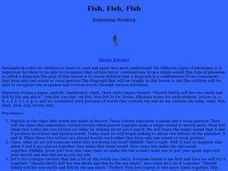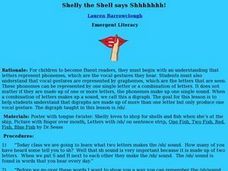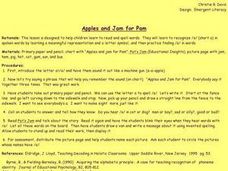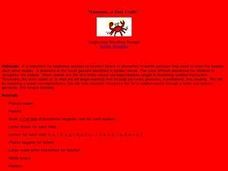Curated OER
Why Koala Has A Stumpy Tail
Students examine Australian folktales. In this folktales instructional activity, students read the Australian folktale, Why Koala Has a Stumpy Tale. Students list characteristics of the characters from the book. Students act out these...
Curated OER
Cluster VC Words (2)
In this word work instructional activity, students work with words that have the VC spelling pattern. They write the names for 6 pictures using the blank lines below them. They fill in the missing sounds to make 9 more four letter words.
Curated OER
"Aaah" Says the Doc
Young scholars complete a variety of activities as they explore/review the letter 'o' as it makes the short /o/ sound. They recite short /o/ tongue twisters, practice writing the letter 'o', and listen to stories, identifying words with...
Curated OER
Fish, Fish, Fish
Pupils identify the digraph /sh/ in written and spoken language. After a brief discussion the independent and combined sounds of the phonemes /s/ and /h/ students practice identifying initial and final placement of the new digraph /sh/...
Curated OER
The B Beat
Students recognize letter b in print and respective phoneme /b/ in spoken words, such as tongue twisters. Students then listen for phoneme in spoken words, and practice writing letter b.
Curated OER
Choo Choo Train
First graders study the sound and spelling of the /ch/ digraph. They repeat words containing the "ch" before making words using their Elkonin letterboxes and letter manipulatives. Next, they clap each time they hear the "ch" digraph...
Curated OER
Fish Wish
Students identify the digraph /sh/ in written and spoken language. After a reading of a decodable story containing the digraph, students practice identifying the initial and final placement of the new digraph /sh/ in words using a...
Curated OER
Creaky Door e
First graders observe as the letter "e' is shown on the overhead projector and discuss the letter's name and what sound it makes. They compare the letter's sound to a creaky door and practice making the /e/ sound. They try saying the...
Curated OER
Ew!!! It's Icky Sticky!
Students engage in an emergent literacy lesson that focuses upon the skill of phonemic awareness. The phoneme sound for the letter "i" is used with a tongue twister to build this important reading skill.
Curated OER
Shelly the Shell
First graders identify the digraph /sh/ in written and spoken language. Students practice the production of the /sh/ sound through word practice and stories. They identify the initial and final placement of the new digraph /sh/ using a...
Curated OER
Purple Polly Platypus
First graders compare the /p/ sound to the sound of popcorn popping in the microwave and practice making the /p/. They try a tongue twister listening for the /p/ sound for the first time and then clapping when they hear the sound the...
Curated OER
Fish Wish
Students identify /sh/ sound when reading and writing words with the /sh/diagraph. They practice saying "Shhhh" and then read the tongue twister "She sells sea shells and fish by the sea shore." They complete a worksheet circling...
Curated OER
Don't Wake Mama
Students identify the digraph /sh/ in written and spoken language. After a brief discussion of the independent and combined sounds of the phonemes /s/ and /h/ students practice identifying initial and final placement of the new digraph...
Curated OER
Droopy Dog says....
Students study the /d/ sound by making the sound and determining where their tongue is when the make it. They repeat a tongue twister while emphasizing the /d/ sounds. Next, they identify the sound in words as the teacher uses a puppet...
Curated OER
Catch the Sneezing /a/
Students study the /a/ in both written and spoken words. They find the sneezing /a/ while saying words and reciting a tongue twister before they practice writing the letter 'a.' As they listen to a read aloud of 'Pat's Jam," they sneeze...
Curated OER
Apples and Jam for Pam
Students study the /a/ phoneme in written and spoken words by making the sound and identifying it in words. They repeat a phrase three times and write lower case a's on primary paper. Next, they listen to "Pat's Jam" and blink their eyes...
Curated OER
"Aaaaaaa...a Fast Crab! "
Students participate in an emergent literacy lesson that focuses on the skill of phonemic awareness. The phoneme chosen is the letter "a". They need to correlate the sound to the letter.
Curated OER
Aaaaa! I'm at the Doctor
Students develop Phoneme awareness of a letter. They explore pictures, hand gestures, tongue twisters, and sounding out the letter. The i will be represented through a picture of an i and students circle the words with the...
Curated OER
School-Home Links: Putting Sounds Together to Make Words
In this word sounds worksheet, 1st graders look at each letter in each word. Students say all of the sounds the letters make in the word. Students repeat the sounds and then say the word.
Curated OER
My Dentist Doesn't Make Me Say /o/
Learners study the o=/o/ correspondence in written and spoken word. They listen to the sound and watch how their mouths move as they make it. They recite a tongue twister and write both upper and lower case o's. Using two colors of...
Curated OER
Load the Boat To Travel the Moat
Learners discover that letters stand for phonemes. They determine that spellings map out the phonemes that are found in spoken words. They analyze the correspondence, oa = /O/ and recognize the /O/ sound in spoken and written words in...
Curated OER
Uh, Bugs
Students recognize the short vowel u in written and spoken language. Through listening activities, they discriminate the vowel sound /u/ from other phonemes. Students associate the phoneme with its letter representation and identify the...
Curated OER
Uhhh...Did I Do That?
Pupils complete a variety of activities as they explore the letter u as it makes the short /u/ sound. They recite short /u/ tongue twisters and using Elkonin letter boxes, they spell words with the letter u. They also practice writing...
Curated OER
School-Home Links: Ending Sounds
In this ending sounds instructional activity, students name each pictures and listen for the last sound. Students then write the letter for the last sound they hear.




